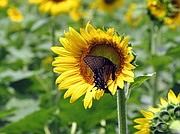Some fields of sunflowers will be in peak bloom by July 22-23, while others will peak by July 29-30. Three of the fields are right along River Road. Photo by Mary Kimm.
From the state Department of Natural Resources (http://dnr.maryland.gov/wildlife/Pages/publiclands/central/mckeebeshers.aspx)
Located on River Road in Western Montgomery County, McKee-Beshers Wildlife Management Area is a 2,000-acre tract in a mixture of woodlands, fields, wooded bottomland and managed wetland impoundments (green-tree reservoirs). The Wildlife Management Area shares a common boundary with the National Park Service Chesapeake and Ohio Canal to the south and borders Seneca Creek State Park, a 1,200-acre public hunting area, on the east.
What To See
McKee-Beshers Wildlife Management Area provides habitat for a great diversity of wildlife species including deer, wild turkey, waterfowl, more than 200 species of songbirds, and numerous reptiles and amphibians. Biologists deliberately flood forests during the fall and winter in "greentree reservoirs." These attract colorful wood ducks as well as other waterfowl which migrate through or spend the winter here.
What To Do
Hikers will find trails for miles and miles, meandering through the forests, fields and wetlands. The C&O Canal and trail actually border the area. From here, you can hike or bicycle east all the way to Washington, D.C. or west as far as Cumberland.
Hunters enjoy the pursuit of white-tailed deer, wild turkey, woodcock, squirrels, doves, waterfowl and many other species.




